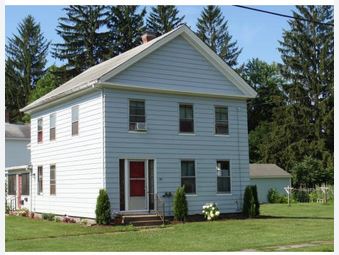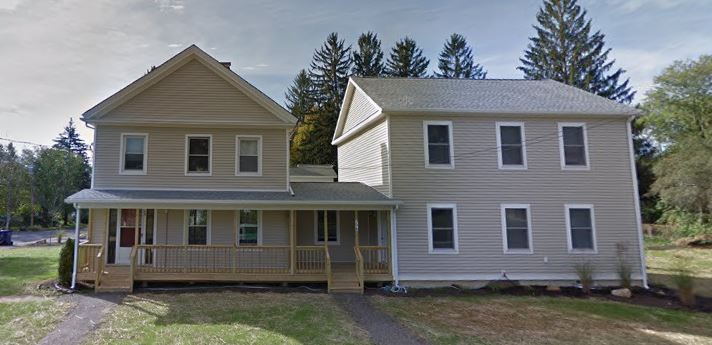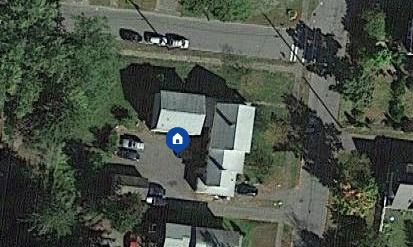Opinion: On Duplexes And Amherst

79 Taylor Street prior to conversion to a duplex (ca. 2010). Photo: Zillow.com
As discussions continue on two councilors’ proposal to pave the way for denser residential options that require less oversight from Town permitting boards, (see also here) I’d like to offer some ideas for Indy readers to consider.
Here’s an interesting article from 2019 about Oregon and duplexes (and more), and about so-called “missing middle housing” in general.
Almost four years have passed since this bill was signed into law, having received surprising and bipartisan support. However, given the pandemic, it is likely too soon to judge whether the development that has resulted from its passage is what supporters hoped to achieve, or whether the unexpected and undesirable has occurred.
It is also important to look at the numbers affected by this law. Cities of over 25,000 residents would see greater opportunities to build not only duplexes, but also triplexes and more on some lots; however, only 26 of 418 cities and towns in Oregon (6%) meet this population level. And of those 26, only 19 have a population of over 30,000. Cities of over 10,000 residents would see duplexes legalized on many city lots, but only 66 cities in total (including the previously cited 26), which make up 16% of the 418, meet this level. So while the legislation applies state-wide, it appears directed at those areas that have met certain urban criteria.
What might all this mean for Amherst? We should consider at least two things.
Despite its current form of government, and despite being the largest municipality in the county in terms of population, Amherst is not really a city, nor is it particularly urban. It has no industrial areas, no true high-rise buildings other than a handful on the UMass campus, no interstates that pass through or even really near it, and no dense residential areas like those in Hampden County. It is a small agricultural town that has continued to increase in population as the university has continued to grow. Its downtown, which until recently consisted of a mix of small shops, residences, and municipal facilities typical of many small New England towns, is surrounded by residential districts with a variety of ages and architectural styles for its buildings. These are our R-G neighborhoods (General Residence), which enjoy a surprising amount of man-made and even wild green space, and which are generally quiet, pleasant, and free of constant traffic, especially during the night-time hours.
“Towns that are polarized in terms of those who have more than enough, and those who must depend on others to have just a little, are not healthy towns. Over the last twenty years, Amherst has moved more and more in this direction.”
While Amherst’s population is nearing 40,000, this number suggests a leaning toward urbanity that in reality is misleading. Because it is home to two colleges and a large state university, a substantial number of Amherst residents are here for only a short period of time, and tend to be less involved in the residential life of the town. They also represent a demographic that is increasingly problematic for the town in terms of what we might call its residential economics. Gone are the days that many of us may remember from the 1960s and 1970s, when college students living off campus felt perfectly at home in cheap and affordable housing that was so because of questionable or few standards. Today’s rentals hold out the promise of luxury that is so wonderful that your parents will wish they could live here (an old Archipelago Investments enticement). And that luxury comes at a price: Rentals are done increasingly by the bedroom, rather than by the apartment, and each bedroom rents in the $1000 range or higher, from anecdotal evidence (rents are often not listed on rental sites). So the meaning of the term “residential economics” is twofold:
1. It refers to the continuing escalation of the price of rentals in Amherst, and the increasing unaffordability of the town to more and more segments of the its population, and
2. It refers to the increasingly lucrative economics, for a small minority of often nonresidents, of what has become one of the town’s primary and seemingly clean industries: residences, particularly those for students.
Towns that are polarized in terms of those who have more than enough, and those who must depend on others to have just a little, are not healthy towns. Over the last twenty years, Amherst has moved more and more in this direction. It is certainly a laudable aim to want Amherst’s residents to represent a broad demographic spectrum. But the current proposal to substantially loosen the permitting process for duplexes and triplexes and other intensive building types, coupled with the seemingly modest and conservative suggestion to try it out first in R-G neighborhoods, is both naive and blind to what has already happened in town.
To serve as an example, one should examine the before (above) and after photos (below) for the duplex conversion at 79 Taylor Street. Here a single-family home was converted into a “duplex” by bringing in not a modest addition, but the equivalent of an entire single-family home, comparable in size or even bigger than the original dwelling. This is a duplex only in the sense that it is physically attached to the existing building. It is now a student rental; it has lost green space – one of the vital but increasingly undervalued aspects of the quality of life in R-G neighborhoods – to the resulting enlargement of parking spaces to accommodate the new residents and the vehicles that almost always come with them.


This is what can and has been done already. Absent the mechanisms of Site Plan Review and Special Permit, which currently provide some measure of protection to abutters and neighborhoods, it will be an open invitation to accelerate such conversions, and given the demand for and the economic rewards to be reaped from student housing, affordable units and those who would live in them will be just a dream. The Planning Board, Town Council and – most importantly – those who live in R-G neighborhoods must approach this proposal dispassionately and analytically, and seek a realistic understanding of both the economic forces at work in the town and the price that the town will pay if they do not.
Denise Barberet lived in Amherst for 34 years and is a current resident of Chicopee

Amherst rents of $1000 per bedroom are less common now than they were 4-5 years ago, especially in newer housing developments. For example, consider the Fieldstone undergrad apartments adjacent to UMass that are leasing now for next school year. Rents there are charged by bedroom. A studio apartment is in the $2200 range, and a 4-bedroom rents for $1504 per bedroom. https://myumassamherstdevelopmentma.prospectportal.com/amherst/fieldstone-slate/student/
Babaret is incorrect. Amherst is an extremely expensive place to live. We have burned all our bridges in terms of providing more affordable housing. The very least we can do is loosen zoning rules to allow just a little more “give” in our out of control housing market. We are not royalty.
Mr. McBride is incorrect. With all the construction of student dorms that is taking place, rents have gone up, not down. The only hope for stabilizing rents and the price of houses for the increasingly “missing middle” is a minimal distance requirement for student housing, a practice that has been used successfully in Newark, Delaware and State College, Pennsylvania and other small college towns with large state universities. Of course this will be vociferously opposed by the student housing industry — absentee landlords, hedge funds, contractors and the council members lawyers, and realtors who serve them. Minimal distance is urgently needed in Amherst and long overdue. The Town is increasingly hemorrhaging year round residents. If our council doesn’t take action, the voters should.
It is clear that Amherst has a housing problem. The price of its homes moves more and more out of the reach of many middle-income wage earners, and its rental market is doing the same. Whether or not this is actually a “crisis” and for whom remains a matter of debate, and also needs to be looked at from a regional and state-wide perspective, to determine the specific peculiarities that apply to Amherst. What should also be clear is that “we need to do something” is a foolhardy approach, particularly when the very proponents of this plan admit that they don’t know what the results will be, and when we do know that the majority of housing in town that has been created in the last 10 years has been for the increasingly lucrative, high-end student rental market.